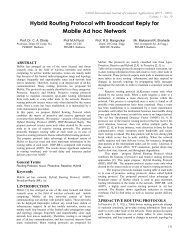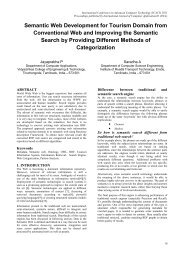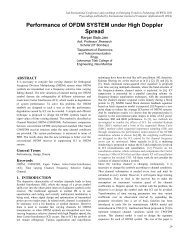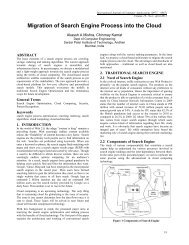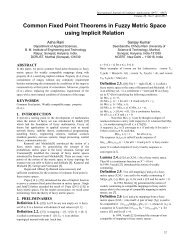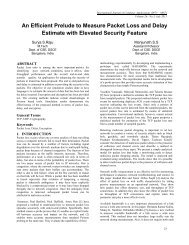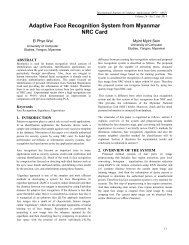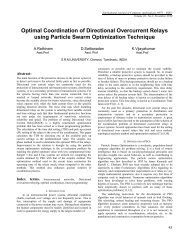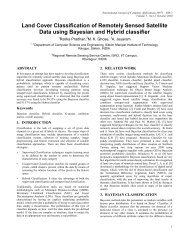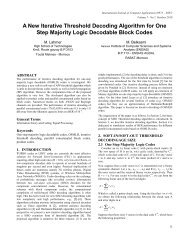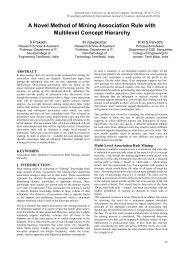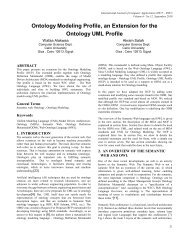Region of Interest Tracking In Video Sequences - International ...
Region of Interest Tracking In Video Sequences - International ...
Region of Interest Tracking In Video Sequences - International ...
Create successful ePaper yourself
Turn your PDF publications into a flip-book with our unique Google optimized e-Paper software.
<strong>In</strong>ternational Journal <strong>of</strong> Computer Applications (0975 – 8887)<br />
Volume 3 – No.7, June 2010<br />
<strong>Region</strong> <strong>of</strong> <strong><strong>In</strong>terest</strong> <strong>Tracking</strong> <strong>In</strong> <strong>Video</strong> <strong>Sequences</strong><br />
T.Johncy Rani<br />
PG Student<br />
Anna University Tirunelveli<br />
Tirunelveli, <strong>In</strong>dia<br />
S.Suja Priyadharsini<br />
Lecturer<br />
Anna University Tirunelveli<br />
Tirunelveli, <strong>In</strong>dia<br />
ABSTRACT<br />
<strong>Tracking</strong> a region-<strong>of</strong>-interest (ROI) in a video is still a<br />
challenging task. Various high level applications rely on<br />
tracking. e.g, motion picture indexing, object recognition, video<br />
surveillance, audiovisual postproduction etc. <strong>In</strong>itially ROI is<br />
defined in a reference frame and the purpose is to determine the<br />
ROI in subsequent target frames in video sequences. The region<br />
was detected by determining the similarity measures between<br />
the reference and the target frames. Similarity measures<br />
between the frames are determined using two classical methods<br />
like sum <strong>of</strong> squared differences(SSD) and sum <strong>of</strong> absolute<br />
differences(SAD). This paper deals with the method <strong>of</strong> ROI<br />
tracking in video sequences by estimating the colour and<br />
geometric features between the frames and the similarity<br />
measures was determined using the Kullback- Leibler<br />
Divergence. The increase <strong>of</strong> description features improves the<br />
accuracy. Their combination leads to high dimensional PDFs.<br />
<strong>Tracking</strong> experiments were performed on several standard<br />
video sequences and its efficiency was proved.<br />
Keywords<br />
<strong>Region</strong>-<strong>of</strong>-interest(ROI), Similarity Measures, Colour and<br />
geometric features, Probability density function, Kullback-<br />
Leibler divergence.<br />
1. INTRODUCTION<br />
<strong>Region</strong>-<strong>of</strong>-interest tracking is a very depth level research area.<br />
ROI tracking is an important problem in the field <strong>of</strong> object<br />
based on video processing. When a physical object appears in<br />
several consecutive frames, it is necessary to identify its<br />
appearance in different frames for the purpose <strong>of</strong> processing.<br />
The colour and geometric features between the reference and<br />
the target frames are the two aspects <strong>of</strong> similarity measures<br />
which is used for ROI tracking. The colour histogram <strong>of</strong> the<br />
object was made in the colour based probabilistic ROI<br />
tracking[5]. This model compute the colour similarity between<br />
the frames. Sum <strong>of</strong> squared differences(SSD) and sum <strong>of</strong><br />
absolute differences(SAD) are the two classical methods which<br />
is used to find the motion compensation error(MSE) between<br />
two consecutive frames[2]. These methods have strict<br />
constraint, since the underlying residual is computed with<br />
deterministic pixel to pixel correspondence between the<br />
reference and target regions. Therefore it is not adapted to<br />
complex motions.<br />
methods by overcoming their respective disadvantages. The<br />
rapid model change in SSD tracker is overcome by the MS<br />
tracker module, while the inability <strong>of</strong> MS tracker to handle<br />
large displacement is circumvented by the SSD module[7].<br />
Different features were integrated into the ROI PDF model<br />
using Gabor or wavelet filters[10]. <strong>In</strong> 2-D Gabor wavelets, 2-D<br />
mesh and a 2-D golden section algorithm based on object<br />
tracking method, the GWT coefficient used to represent the<br />
local colour features and it is able to track objects in a video<br />
sequence with large deformations.<br />
The increase <strong>of</strong> description features improves accuracy their<br />
combination leads to high-dimensional PDFs. There exist<br />
efficient method to estimate multivariate PDFs using Parzen<br />
windowing[6]. Due to fixed cardinality <strong>of</strong> the data set, a<br />
limitation known as the curse <strong>of</strong> dimensionality appears: as the<br />
dimension <strong>of</strong> the domain <strong>of</strong> definition <strong>of</strong> the PDFs gets higher<br />
the domain sampling gets sparser. Hence the resulting PDF is<br />
oversmoothed. The combination <strong>of</strong> colour and geometric<br />
features improves the tracking accuracy[4]. This paper deals<br />
with the colour feature extraction using the colour histogram<br />
model, and the geometric feature extraction using the moment<br />
invariant analysis. Moment invariants are evaluated as feature<br />
space for pattern recognition in terms <strong>of</strong> discrimination power<br />
and noise tolerance[8]-[9]. Geometric moment invariant<br />
produce a set <strong>of</strong> feature vectors that are invariant under shifting,<br />
scaling and rotation which is widely used to extract the global<br />
features for pattern recognition due to its discriminative power<br />
and robustness.<br />
Similarity measures based on the KNN PDF estimator is only<br />
adapted to high dimensions the resulting entropy estimator<br />
appears to be accurate in both low and high dimensions[1]-[13].<br />
We use an estimator for Kullback-Leibler divergence efficient<br />
for high dimensional PDFs. The distance is expressed from the<br />
samples using the Kth nearest neighbour framework(KNN).<br />
2. PROPOSED WORK<br />
The flow chart <strong>of</strong> the ROI tracking algorithm is shown in Fig.1.<br />
The reference frame and target frame from the video frames is<br />
selected first. Then the particular region-<strong>of</strong>-interest is selected<br />
from the reference frame and the (Y,U,V) colour feature was<br />
extracted. The colour and the geometric features are extracted<br />
form the reference and the target frame. Finally, the Kullback<br />
leibler Divergence is used for finding the similarity measure<br />
between the reference and the target frames.<br />
An alternative way for real time tracking <strong>of</strong> non-rigid objects<br />
seen from a moving camera based on the mean shift(MS)<br />
iterations and finds the most probable target position in the<br />
current frame[3]. The dissimilarity between the frames is<br />
expressed by a metric derived from Bhattacharyya coefficient.<br />
Some <strong>of</strong> the object tracking approaches combine two tracking<br />
32
<strong>In</strong>ternational Journal <strong>of</strong> Computer Applications (0975 – 8887)<br />
Volume 3 – No.7, June 2010<br />
Reference frame<br />
ROI window<br />
<strong>Video</strong> frames<br />
Target frame<br />
Windowing operation<br />
Geometric moment mpq <strong>of</strong> image f(x,y) where p,q are nonnegative<br />
integers and (p+q) is called the order <strong>of</strong> the moment, is<br />
defined as<br />
p q<br />
m<br />
pq<br />
x y f ( x,<br />
y)<br />
dxdy<br />
(2)<br />
Corresponding central moment and normalized moment<br />
are denoted as<br />
Colour & geometric feature extraction<br />
Similarity measure using KLD<br />
Tracked object<br />
Fig 1. Flow diagram for tracking<br />
2.1 Colour feature extraction<br />
Normally all the video sequences are in (R,G,B) format. They<br />
are converted into (Y,U,V) format. The components <strong>of</strong> the<br />
feature vectors were normalized as follows: Y,U, and V were<br />
rescaled into the interval [0,1] and the coordinates (x,y) were<br />
rescaled into [-1,1], both the ROI and the candidate regions, the<br />
origin being located at the centre <strong>of</strong> the bounding box region.<br />
<strong>Tracking</strong> was performed with IR being set to I1 while IT was<br />
successively equal to It = 2,3,4… When searching for the ROI<br />
in frame It, the search area was empirically limited to ± 12<br />
pixels horizontally and vertically around the position <strong>of</strong> the<br />
center <strong>of</strong> the ROI computed in frame It-1.<br />
A well-known density estimator is the histogram., the (onedimensional)<br />
histogram is defined as,<br />
1<br />
f ( x)<br />
(number <strong>of</strong> X in the same bin as x) (1)<br />
nh<br />
where n is the number <strong>of</strong> pixels with value X in the image, h is<br />
the bin width and x is the range <strong>of</strong> data. Two choices have to be<br />
made when constructing a histogram. First, the bin-width<br />
parameter needs to be chosen. Second, the position <strong>of</strong> the bin<br />
edges needs to be established. Both choices affect the resulting<br />
estimation.<br />
2.2 Geometric feature extraction<br />
The geometric features are extracted using the moment<br />
invariant analysis. <strong>In</strong> image processing, computer vision and<br />
related fields, an image moment is a certain particular weighted<br />
average (moment) <strong>of</strong> the image pixel’s intensities, or a function<br />
<strong>of</strong> such moments, usually chosen to have attractive property or<br />
interpretation. Image moments are useful to describe objects<br />
after segmentation. There are two types <strong>of</strong> moment invariants.<br />
They are region based and contour based. Here contour based<br />
moment was applied. This moment invariants are used for<br />
computer vision applications, remote sensing, medical imaging,<br />
trademark identification, insect identification and pattern<br />
recognition. Normally the moment invariants are described as<br />
follows:<br />
p<br />
q<br />
( x x ) ( y y ) f ( x,<br />
y dxdx<br />
(3)<br />
pq<br />
)<br />
Where,<br />
m10<br />
m01<br />
x and y<br />
(4)<br />
m m<br />
00<br />
00<br />
The normalized central moment <strong>of</strong> order (p+q) is defined<br />
as<br />
pq<br />
pq<br />
oo<br />
For p+q=0,1,2,….where,<br />
(5)<br />
[( p q) / 2] 1<br />
(6)<br />
A set <strong>of</strong> seven 2-D moment invariants that are insensitive to<br />
translation, scale change, mirroring, and rotation can be derived<br />
from these equations. They are<br />
1 20 02<br />
2<br />
2<br />
(<br />
20 02<br />
) 4<br />
2<br />
11<br />
2<br />
2<br />
3<br />
(<br />
30<br />
3<br />
12<br />
) (3<br />
21 03)<br />
2<br />
2<br />
4<br />
(<br />
30 12<br />
) (<br />
21 03)<br />
5<br />
3(<br />
[3(<br />
6<br />
7<br />
4<br />
[3(<br />
3(<br />
21<br />
(<br />
30<br />
(<br />
11<br />
(<br />
(3<br />
30<br />
21<br />
30<br />
20<br />
30<br />
21<br />
03<br />
12<br />
12<br />
)<br />
3<br />
2<br />
)<br />
03<br />
)<br />
2<br />
]<br />
02<br />
)<br />
2<br />
12<br />
)(<br />
(3<br />
(<br />
)[(<br />
12<br />
03<br />
2<br />
]<br />
)(<br />
)(<br />
(<br />
30<br />
21<br />
30<br />
21<br />
30<br />
(3<br />
21<br />
21<br />
12<br />
12<br />
03<br />
12<br />
03<br />
12<br />
03<br />
The moments invariants are determined for the selected ROI<br />
and the scaled ROI images. The scaling factor was normally<br />
taken between 0.98 to 1.02.<br />
03<br />
)<br />
)<br />
)<br />
)<br />
)[(<br />
2<br />
)(<br />
2<br />
)[(<br />
2<br />
30<br />
]<br />
]<br />
)(<br />
(<br />
30<br />
30<br />
21<br />
21<br />
21<br />
12<br />
12<br />
03<br />
)<br />
03<br />
)<br />
)<br />
03<br />
2<br />
)<br />
2<br />
)<br />
2<br />
]<br />
33
<strong>In</strong>ternational Journal <strong>of</strong> Computer Applications (0975 – 8887)<br />
Volume 3 – No.7, June 2010<br />
moments<br />
1<br />
2<br />
3<br />
4<br />
5<br />
6<br />
7<br />
Table 1. 2-D moment invariants<br />
2.3. Similarity measures<br />
Let IR be the reference frame in which the ROI is defined and<br />
IT is the target frame in which the ROI is determined using the<br />
similarity measures. The amount <strong>of</strong> similarity is given by the<br />
geometric transformation<br />
arg min<br />
Sample video 1 Sample video 2<br />
Original<br />
Original<br />
Scaled ROI<br />
Scaled ROI<br />
ROI<br />
ROI<br />
0.0013261 0.0013315 0.0013235 0.0013264<br />
2.059e-09 1.87e-09 1.33e-08 1.349e-08<br />
1.05e-10 1.057e-10 6.314e-11 6.269e-11<br />
1.20e-10 1.217e-10 7.51e-11 7.437e-11<br />
1.09e-20 1.10e-20 4.05e-21 4.083e-21<br />
-1.15e-10 -1.16e-10 -7.36e-11 -7.31e-11<br />
8.07e-21 8.307e-21 3.216e-21 3.018e-21<br />
D<br />
KL<br />
( I<br />
R<br />
, I<br />
T<br />
)<br />
Where DKL is the Kullback Leibelr divergence between the<br />
reference and the target frames. Normally similarity measures<br />
are determined in two ways. They are colour based and<br />
geometry based. The colour based method checks if the regions<br />
have similar colours and the geometry checks if these colours<br />
appear at the same location.<br />
(7)<br />
between the reference and the target frames. A function <strong>of</strong><br />
residual can serve as a similarity measure, classically in the<br />
discrete framework, SSD<br />
D<br />
SSD<br />
( I<br />
2<br />
T ,<br />
I<br />
R)<br />
( T ( x)<br />
R(<br />
x))<br />
x<br />
(11)<br />
Or function used in robust estimation such as SAD or<br />
differentiable approximation <strong>of</strong> SAD<br />
D ))<br />
SAD( IT<br />
,<br />
I<br />
R)<br />
( T ( x)<br />
R(<br />
x<br />
(12)<br />
x<br />
3. EXPERIMENTAL RESULTS<br />
This algorithm had been tested on several video datasets. The<br />
appearance <strong>of</strong> the object and its background keep changing<br />
during almost all the time. The exciting results are obtained in<br />
most experiments. Here three video sequences are used to test<br />
the ability <strong>of</strong> the algorithm to track object deformations and<br />
shifts. Only the first frame in every 30 frames is used to force<br />
the motion and deformations to be large. <strong>In</strong> the first frame, a<br />
rectangle is interactively selected by the user. Although the user<br />
specifies a rectangle to cover the object to find the feature point<br />
selection, all the feature points are located inside the object. The<br />
experiments also prove that the tracking algorithm is very<br />
efficient.<br />
3.1 Experiment-I<br />
This video sequence consists <strong>of</strong> 174 frames and 29.966 frames<br />
per second. Here the window size is changed to 80X80. This<br />
will result more tracking accuracy than the previous video.<br />
Fig.2. shows the tracking results <strong>of</strong> the particular ROI.<br />
2.3.1. Colour based similarity measures<br />
One <strong>of</strong> the colour based similarity measure used for tracking is<br />
Bhattacharya distance.<br />
DBHA ( IT<br />
, IR)<br />
fR(<br />
s)<br />
fT<br />
( s)<br />
ds<br />
(8)<br />
Another widely used similarity measure is the Kullback-<br />
Leibler distance<br />
D<br />
KL<br />
( I , I )<br />
T<br />
R<br />
f ( s)log<br />
T<br />
fT<br />
( s)<br />
ds<br />
f ( s)<br />
R<br />
(9)<br />
Frame 1<br />
This equation can be decomposed as follows<br />
DKL ( IT<br />
,<br />
I<br />
R)<br />
fT<br />
( s)log<br />
fT<br />
( s)<br />
ds<br />
fT ( s)log<br />
fR(<br />
s)<br />
ds<br />
= I ) H ( I , I )<br />
H (10)<br />
(<br />
T<br />
T R<br />
Where H is the differential entropy and HX is the cross entropy,<br />
also called relative entropy or likelihood.<br />
2.3.2. Geometry based similarity measures<br />
Frame 30<br />
Frame 60<br />
Geometry can be added by using transformation , which<br />
represents a motion model, to compute the pointwise residual<br />
34
<strong>In</strong>ternational Journal <strong>of</strong> Computer Applications (0975 – 8887)<br />
Volume 3 – No.7, June 2010<br />
Table 2. Comparison between colour based and<br />
colour+Geometric feature tracking<br />
Frame 90<br />
Window<br />
position<br />
Sample<br />
video1<br />
Sample<br />
video2<br />
Frames<br />
Colour based<br />
tracking<br />
Colour + Geometry<br />
based tracking<br />
Row Column Row Column<br />
Frame1 9 46 10 46<br />
Frame30 20 46 20 56<br />
Frame60 20 39 20 40<br />
Frame1 14 58 15 55<br />
Frame30 20 33 22 35<br />
Frame60 6 15 18 23<br />
Frame 120<br />
Fig.3. ROI tracked in frame 1,30,60,90,120.<br />
3.2Experiment-II<br />
This video sequence consists <strong>of</strong> 103 frames and 29.96 frames<br />
per second. Here the window size is changed to 80X80. Fig.4.<br />
shows the tracking results <strong>of</strong> the particular ROI.<br />
The tracking accuracy improvement in the video samples was<br />
compared using the Kullback Leibler divergence between the<br />
frames. Minimum values <strong>of</strong> divergence denote better tracking in<br />
the video frames.<br />
Table 3. Kullback Leibler divergence<br />
Kullback Leibler Divergence<br />
Colour<br />
tracking<br />
based<br />
Sample video1 0.0469<br />
Sample video2 0.0481<br />
Frame 1<br />
Colour + Geometry<br />
based tracking<br />
Sample video1 0.0438<br />
Sample video2 0.0467<br />
Frame 30<br />
4. CONCLUSION<br />
This paper presented an approach for tracking the region-<strong>of</strong>interest<br />
(ROI) used by the combination <strong>of</strong> (Y,U,V) colour<br />
features with the moment invariant geometric features. Here the<br />
similarity measures are determined by using Kullback-Leibler<br />
divergence. Experiments proved that ROI was perfectly tracked<br />
with high accuracy. <strong>In</strong> future tracking will be done using<br />
Bregman divergence [11] and the geometric features are<br />
extracted using Gabor wavelets. This work can be further<br />
extended to track more than one object in video sequences.<br />
5. REFERENCES<br />
Frame 60<br />
Fig.3. ROI tracked in frame 1,30,60.<br />
[1] Sylvain Boltz, Eric Debreuve, & Michel Barlaud, 2009<br />
High-Dimensional statistical measure for region-<strong>of</strong>-interest<br />
tracking, IEEE Transactions on image processing,<br />
Vol.18,No.6,ppl 1266-1283.<br />
[2] S. Boltz, A. Herbulot, E. Debreue, M. Barlaud, & G.<br />
Aubert, 2008.Motion and appearance nonparametric joint<br />
entropy for video segmentation <strong>In</strong>t.J. comput. Vis, vol<br />
80,no.2, 242-259.<br />
[3] D. Comaniciu, V. Ramesh, & P.Meer, 2000.Real-time<br />
tracking <strong>of</strong> non-rigid objects using mean shift, presented at<br />
<strong>In</strong>t. conf. computer vision and pattern recognition.<br />
35
<strong>In</strong>ternational Journal <strong>of</strong> Computer Applications (0975 – 8887)<br />
Volume 3 – No.7, June 2010<br />
[4] T. Brox, M. Rousson, R. Deriche, & J. Weckert, 2003.<br />
Unsupervised segmentation incorporating colour, texture,<br />
and motion, presented at the computer analysis <strong>of</strong> Images<br />
and Patterns, Groningens, the Netherlands.<br />
[5] P. Perez, C. Hue, J. Vermaak, & M. Gangnet, 2002.colourbased<br />
probabilistic tracking”, Presented at the European<br />
conf. computer vision, Copenhagen, Denmark.<br />
[6] S. Boltz, E. Wolsztynski, E. Debreuve, E. Thierry, M.<br />
Barlaud, & L. Pronzato, 2006.A minimum-entropy<br />
procedure for robust motion estimation”, presented at the<br />
<strong>In</strong>t. conf.Image Processing, AtlandaGA.<br />
[7] R.V. Babu, P. Perez, & P. Bouthemy,2007. Robust<br />
tracking with motion estimation and local kernel-based<br />
colour modeling, Image Vis.comput. vol.25.no.8,ppl1205-<br />
1216.<br />
[8] Yaser S. Abu-Mostafa & Demetri Psaltis, 1984.<br />
Recognitive aspects <strong>of</strong> moment invariants, IEEE<br />
Transactions on pattern analysis and machine intelligence,<br />
Vol.PAMI-6,No. 6, ppl 698-706.<br />
[9] Mohamed Rizon, Haniza Yazid, Mohd Rozailan Mamat,<br />
2006 .bject detection using geometric invariant moment,<br />
American Journal <strong>of</strong> Applied Sciences 2(6): 1876-1878.<br />
[10] Chao He, Yuan F. Zheng, and Stanley C. Ahalt,<br />
2002.Object tracking using the Gabor wavelet transform<br />
and the golden selection algorithm, IEEE Transaction on<br />
Multimedia Vol 4.No.4, 528-538.<br />
[11] A. Banerjee, S. Merugu, I. Dhillon, & J. Ghosh,<br />
2005.Clustering with bregman divergence”, J. Mach.<br />
Learn. Res vol. 6,1705-1749.<br />
[12] A. Bugeau and P. Perez, 2007.Detection and segmentation<br />
<strong>of</strong> moving objects in highly dynamic scenes”, presented at<br />
the <strong>In</strong>t. Conf. Computer vision and pattern recognition,<br />
Minneapolis,MN.<br />
[13] Paolo Piro, Sandrine Anthoine, Eric Debreuve, Michel<br />
Barlaud, 2008. Image retrieval via kullback leibler<br />
divergence <strong>of</strong> patches <strong>of</strong> multiscale coefficients in the<br />
KNN framework”, published in CSMI 2008, proceeding <strong>of</strong><br />
the <strong>In</strong>ternational workshop on content-based multimedia<br />
indexing.<br />
36


